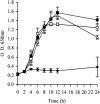An in vitro study of the probiotic potential of a bile-salt-hydrolyzing Lactobacillus fermentum strain, and determination of its cholesterol-lowering properties
- PMID: 12902267
- PMCID: PMC169108
- DOI: 10.1128/AEM.69.8.4743-4752.2003
An in vitro study of the probiotic potential of a bile-salt-hydrolyzing Lactobacillus fermentum strain, and determination of its cholesterol-lowering properties
Abstract
This study evaluated the use of a bile-salt-hydrolyzing Lactobacillus fermentum strain as a probiotic with potential hypocholesterolemic properties. The effect of L. fermentum on representative microbial populations and overall metabolic activity of the human intestinal microbiota was investigated using a three-stage continuous culture system. Also, the use of galactooligosaccharides as a prebiotic to enhance growth and/or activity of the Lactobacillus strain was evaluated. Administration of L. fermentum resulted in a decrease in the overall bifidobacterial population (ca. 1 log unit). In the in vitro system, no significant changes were observed in the total bacterial, Lactobacillus, Bacteroides, and clostridial populations through L. fermentum supplementation. Acetate production decreased by 9 to 27%, while the propionate and butyrate concentrations increased considerably (50 to 90% and 52 to 157%, respectively). A general, although lesser, increase in the production of lactate was observed with the administration of the L. fermentum strain. Supplementation of the prebiotic to the culture medium did not cause statistically significant changes in either the numbers or the activity of the microbiota, although an increase in the butyrate production was seen (29 to 39%). Results from this in vitro study suggest that L. fermentum KC5b is a candidate probiotic which may affect cholesterol metabolism. The short-chain fatty acid concentrations, specifically the molar proportion of propionate and/or bile salt deconjugation, are probably the major mechanism involved in the purported cholesterol-lowering properties of this strain.
Figures




Similar articles
-
Probiotic Characterization of Cholesterol-Lowering Lactobacillus fermentum MJM60397.Probiotics Antimicrob Proteins. 2020 Sep;12(3):1161-1172. doi: 10.1007/s12602-019-09585-y. Probiotics Antimicrob Proteins. 2020. PMID: 31432401
-
Cholesterol-Lowering Effects of Lactobacillus Species.Curr Microbiol. 2020 Apr;77(4):638-644. doi: 10.1007/s00284-020-01903-w. Epub 2020 Feb 4. Curr Microbiol. 2020. PMID: 32020463 Review.
-
Bile salt deconjugation and cholesterol removal from media by Lactobacillus strains used as probiotics in chickens.J Sci Food Agric. 2010 Jan 15;90(1):65-9. doi: 10.1002/jsfa.3780. J Sci Food Agric. 2010. PMID: 20355013
-
Lactobacillus fermentum NCIMB 5221 and NCIMB 2797 as cholesterol-lowering probiotic biotherapeutics: in vitro analysis.Benef Microbes. 2015;6(6):861-9. doi: 10.3920/BM2015.0021. Epub 2015 Aug 31. Benef Microbes. 2015. PMID: 26322545
-
Probiotics--interactions with bile acids and impact on cholesterol metabolism.Appl Biochem Biotechnol. 2012 Dec;168(7):1880-95. doi: 10.1007/s12010-012-9904-4. Epub 2012 Oct 4. Appl Biochem Biotechnol. 2012. PMID: 23054820 Review.
Cited by
-
Beneficial Properties of Probiotics.Trop Life Sci Res. 2016 Aug;27(2):73-90. doi: 10.21315/tlsr2016.27.2.6. Trop Life Sci Res. 2016. PMID: 27688852 Free PMC article.
-
Cloning and characterization of the bile salt hydrolase genes (bsh) from Bifidobacterium bifidum strains.Appl Environ Microbiol. 2004 Sep;70(9):5603-12. doi: 10.1128/AEM.70.9.5603-5612.2004. Appl Environ Microbiol. 2004. PMID: 15345449 Free PMC article.
-
Functional and probiotic attributes of an indigenous isolate of Lactobacillus plantarum.PLoS One. 2009 Dec 1;4(12):e8099. doi: 10.1371/journal.pone.0008099. PLoS One. 2009. PMID: 19956615 Free PMC article.
-
Comparative genome analysis of Megasphaera sp. reveals niche specialization and its potential role in the human gut.PLoS One. 2013 Nov 18;8(11):e79353. doi: 10.1371/journal.pone.0079353. eCollection 2013. PLoS One. 2013. PMID: 24260205 Free PMC article.
-
Impact of Fermentation Pretreatment on Drying Behaviour and Antioxidant Attributes of Broccoli Waste Powdered Ingredients.Foods. 2023 Sep 22;12(19):3526. doi: 10.3390/foods12193526. Foods. 2023. PMID: 37835180 Free PMC article.
References
-
- Bernalier, A., J. Dore, and M. Durand. 1999. Biochemistry of fermentation, p. 37-53. In G. R. Gibson and M. B. Roberfroid (ed.), Colonic microbiota, nutrition and health. Kluwer Academic Publishers, Dordrecht, The Netherlands.
-
- Charteris, W. P., P. M. Kelly, L. Morelli, and J. K. Collins. 1998. Development and application of an in vitro methodology to determine the transit tolerance of potentially probiotic Lactobacillus and Bifidobacterium species in the upper human gastrointestinal tract. J. Appl. Microbiol. 84:759-768. - PubMed
-
- Chikai, T., H. Naka, and K. Ushida. 1987. Deconjugation of bile acids by human intestinal bacteria implanted in germ-free rats. Lipids 22:669-671. - PubMed
-
- Corzo, G., and S. E. Gilliland. 1999. Bile salt hydrolase activity of three strains of Lactobacillus acidophilus. J. Dairy Sci. 82:472-480. - PubMed
Publication types
MeSH terms
Substances
LinkOut - more resources
Full Text Sources
Other Literature Sources

